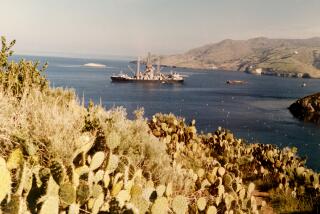U.S. Researchers Hope to Find Navy’s First Sub
- Share via
An unlikely discovery in France’s naval archives has put American researchers hot on the trail of the Union submarine Alligator, the U.S. Navy’s first commissioned submarine and the first to enter a combat zone.
Unlike its Confederate counterpart, the H. L. Hunley, the ill-fated Alligator didn’t sink any ships or kill anybody, neither enemy sailors nor its own crew. And when it was lost in a fierce storm off Cape Hatteras, N.C., in 1863, it was nearly lost to history as well.
A recent discovery in the French archives of the vessel’s blueprints, however, has stimulated new interest in the ship and has prompted federal authorities to try to find and raise it.
The search is also sparking interest in the vessel’s mysterious creator, Brutus De Villeroi, an eccentric Frenchman who listed his occupation on the 1860 census as “natural genius.”
“The Alligator Project will test our ability to find an object in the sea in a reasonable amount of time and at a reasonable cost,” said Rear Adm. Jay Cohen, chief of Naval Research. “If we can find the Alligator, we can find anything.”
The Office of Naval Research is mounting the search in conjunction with the National Oceanic and Atmospheric Administration.
Already, a team of midshipmen from the U.S. Naval Academy is charting weather and oceanic data for the date of the sinking in an attempt to determine where the Alligator may have drifted after it was cut loose from the ship towing it from Washington to Port Royal, S.C.
“What makes the Alligator so compelling is that it combines history, mystery and technology,” said Daniel J. Basta, director of NOAA’s National Marine Sanctuary Program.
“The vessel has a lot of firsts associated with it, which is what makes it so important,” said naval historian James Christley. In addition to being the first Navy sub and the first deployed to a combat zone, it was the first to have a diver’s lockout chamber, the first to have onboard air compressors for air renewal and diver support, and the first to have a test run witnessed by a U.S. president, Abraham Lincoln.
“As a warship, it doesn’t have a real great combat record,” Christley said, “but that doesn’t make it any less important.”
The blueprints were discovered in a box of documents from inventors whose ideas had been rejected by the French government.
De Villeroi, about whom surprisingly little is known, began designing submarines in the 1830s and made several proposals to the French government, all of which were turned down. In his last approach, in 1865, he attached a copy of the design he did for the U.S. government, apparently in an attempt “to prove his credentials,” said Catherine Marzin, a researcher for the National Marine Sanctuary Program who found the blueprints.
All his letters and the French responses were in the archives. “They had everything,” Marzin said. “We couldn’t find any indication of the blueprints in the United States. It was an exciting moment.”
The story of the Alligator began in early 1861, when Philadelphia newspapers reported that police had captured a partially submerged, 33-foot-long, cigar-shaped “infernal machine” moving slowly down the Delaware River.
Although police initially suspected it was an enemy vessel, it was actually an experimental ship produced by De Villeroi in an attempt to convince the Union Navy that he could build a working submersible warship.
His apparent publicity stunt worked, and by November he was under contract to build the Union’s first submarine. The 47-foot-long Alligator was constructed in Philadelphia out of riveted iron plates at a cost of $14,000. Arguably, its most unique feature was that it was powered by oars operated by a 20-man crew.
The oars were designed to give the vessel maneuverability as it operated in rivers and harbors, Christley said.
The Alligator was designed to maneuver close to an enemy target and deploy a helmeted diver, who would attach a limpet mine to the target. The mine would then be detonated electrically.
About a month after its launch on May 1, 1862, the Alligator was towed to Hampton Roads, Va., where its mission was to destroy a strategically important bridge on the Appomattox River and to clear away obstructions in the James River. Both rivers proved too shallow for it to submerge, however, and the vessel was withdrawn for more testing.
In August 1862, Lt. Thomas O. Selfridge accepted command of the submarine after being promised promotion to captain if the vessel destroyed the new Confederate ironclad Virginia II. During test runs in the Potomac River, however, the Alligator was found to be underpowered and unwieldy, prompting Selfridge to label it “a failure.”
The quest to sink the Virginia II was abandoned, and the Alligator was sent to dry dock for repairs. The oars were exchanged for a large propeller at the rear, powered by a crank similar to that on the Hunley. In the spring of 1863, Lincoln witnessed a demonstration of the “improved” vessel.
Shortly after, it was ordered to Charleston, S.C., under tow by the decrepit Union ship Sumpter. The Sumpter was barely able to withstand the storm it encountered, and the Alligator was cut loose, never to be seen again.
The following year, the Hunley became the first submarine to sink an enemy vessel, before it sank with all hands.
The next 35 years saw a series of experimental submersibles until John Philip Holland solved the crucial problem of propelling a submersible by combining an internal combustion engine for surface travel with a battery-operated electric motor for operation under the surface.
The Holland was commissioned in October 1900, the first of an unbroken line of submarines operated by the U.S. Navy.
More to Read
Sign up for Essential California
The most important California stories and recommendations in your inbox every morning.
You may occasionally receive promotional content from the Los Angeles Times.













